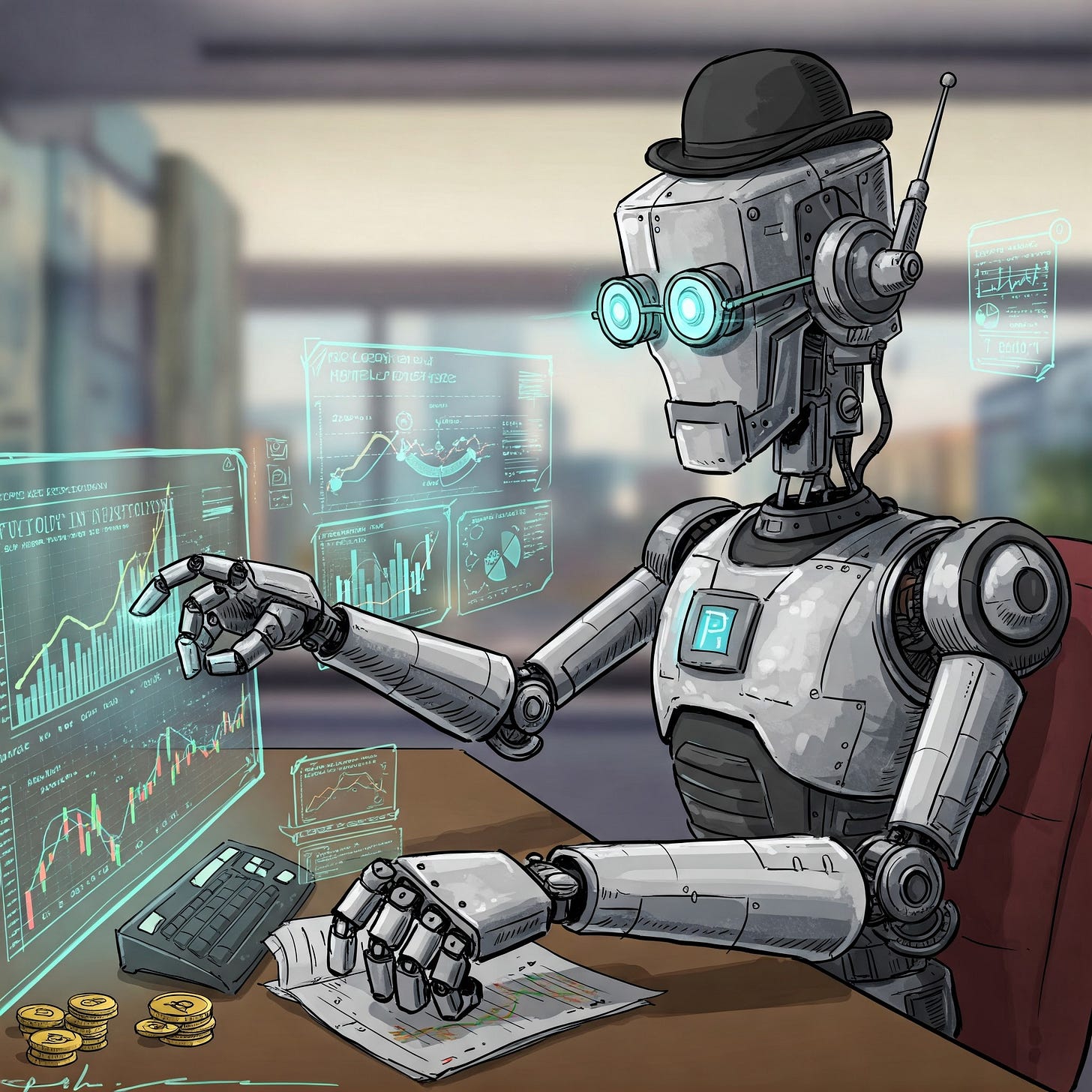Generative Convergence Reflexivity (GCR): A Hypothesis on AI-Driven Investor Herding & Stock Bubbles
Are a non-insignificant % of AI/LLM users throwing $ on the same moonshot stock picks?
This is just something I thought of that may or may not exist… It’s purely hypothetical and it would be difficult to actually track/study.
My hypothesis is that a massive uptick in the number of people using AI’s like ChatGPT, Claude, Gemini, DeepSeek, Grok, Llama, etc. — leads a reasonable % of people to ask for specific stock picks/investments for maximum returns.
People want to get rich quick (this won’t ever stop). They chat away and ask ChatGPT: which are the best investments to make the most money over the next: 5-years, 10-years, 15-years, etc. Or what is most likely to be the “next NVIDIA” or “next Tesla” or “next Bitcoin.”
The LLMs spit out fairly predictable answers. If you have enough people asking variants of these questions… you get similar responses.
Not everyone acts on these responses, but if a certain % do, you could end up with bubbles like we’re seeing in quantum computing (moonshot picks like IonQ valued at $8.4B with just ~$50M annual revenue).
Bubbles have always existed, but certain niche bubbles may end up bigger as a result of this LLM effect (particularly if there’s preexisting: trends, media hype, and/or bull market structure).
Note: In addition to these stocks being in early-stage bubbles (detached from revenue/products), it is possible that over the long-term they end up becoming massive (such that many “LLM-advice” investors hit pay-dirt from the speculative recommendations. This is unlikely, but not impossible. There could also be phases of Ponzi-like/greater-fool game theory type dynamics in early stages too (sharks dump bags post-pump).
LLM Investment Brainstorming (ChatGPT Effect)
Advancements in Generative AI—especially Large Language Models (LLMs) such as ChatGPT, Gemini, Claude, Grok, DeepSeek, etc.—have created new ways for individuals to seek and share investment ideas.
An increasing number of users ask these chatbots for “the next moonshot,” “highest growth opportunities,” or “best stock picks to maximize returns.”
My hypothesis suggests that when a critical mass of market participants receives similar or identical recommendations from these AI tools, a self-reinforcing market dynamic may emerge, potentially inflating stock prices irrespective of fundamental value.
Important: This is purely theoretical and does not constitute investment advice. Markets are influenced by myriad factors, and the specific influence of AI chatbot suggestions has not been rigorously proven or quantified.
Hypothesis: Generative Convergence Reflexivity (GCR)
I’ll refer to this hypothesized feedback loop as Generative Convergence Reflexivity (GCR). I had ChatGPT brainstorm various terms for this potential phenomenon and settled on GCR.
It entails:
Generative: AI models produce novel, text-based outputs.
Convergence: Large numbers of users receive similar recommendations.
Reflexivity: Price increases reinforce investor belief in the AI’s “accuracy,” prompting further buying and continued price appreciation, at least in the short run.
Mechanism of the GCR Phenomenon
A. Rapid Growth of Chatbot Adoption
Explosive User Growth: Generative AI chatbots have seen some of the fastest adoption rates in tech history. Within months of launch, leading LLMs reached millions of active users. The more people using chatbots, the more simultaneous exposure to similar investment ideas.
Ease of Access: Many LLMs are freely accessible or extremely low-cost. This barrier-free environment encourages high daily usage among both retail and novice investors who might not have traditional financial education.
B. Homogenized “Moonshot” Recommendations
Model Architecture and Training Data: LLMs are trained on overlapping corpuses (news articles, financial blog posts, social media discussions). When asked for the “best 10- or 20-year investments,” they often highlight recurring high-growth themes (e.g., quantum computing, electric vehicles, AI hardware, space tech). (e.g. IonQ, Tesla, NVIDIA, Rocket Lab).
Predictable Overlaps: Because these models share underlying patterns, they often converge on the same set of “futuristic” or “game-changing” industries—even across different chatbot platforms. This homogeneity can be especially pronounced for niche sectors without many competing publicly listed companies.
C. Illusion of Exclusive AI Wisdom
Perceived Authority: Despite standard disclaimers (“I’m not a financial advisor”), the linguistic fluency and confident tone of generative AI can lead users to perceive these recommendations as exceptionally insightful or prescient.
Confirmation Bias: Investors with a predisposition toward speculative “moonshot” ideas see AI suggestions as confirmation of their beliefs. This reinforces their conviction and willingness to commit capital.
D. Network Effect Leading to Micro-Bubbles
Convergence of Buyers:
Thousands (or potentially millions) of users simultaneously receive the same tickers or sectors highlighted by chatbots.
A portion of these users act quickly, buying shares in the recommended companies.
Price Appreciation:
If trading volume is not large—especially in small- or mid-cap stocks—these new orders can meaningfully push prices upward, sometimes rapidly.
Newsfeeds, social media, and subsequent AI prompts register the rise in share price, further amplifying the signal.
Reflexive Reinforcement:
The price jump validates the AI’s recommendation for early buyers, who then share success stories on social media (e.g., “The chatbot was right!”).
More users, noticing the hype or hearing of quick gains, pile in—whether guided by FOMO or repeat AI prompts.
Micro-Bubble Formation:
Over certain timeframes (especially during “bullish” market conditions), valuations can become detached from fundamentals. This is akin to a micro-bubble, concentrated in a handful of “AI-anointed” stocks or sectors.
Potential Correction:
If actual company earnings or progress fails to meet lofty expectations, sentiment can shift abruptly.
Latecomers to the trend may suffer significant losses once the bubble deflates during a major macro downturn.
Why This Phenomenon Could Amplify in Bull Markets
A.) Elevated Risk Appetite
In bullish environments, investors and speculators are more inclined to chase high-upside “moonshots,” looking for multi-bagger gains. AI-generated picks—often focusing on disruptive innovation—fit perfectly into a bull market mindset.
B.) Abundant Liquidity
During uptrends, credit is cheaper, cash positions are higher, and traders are more willing to allocate risk capital to speculative bets. The availability of liquidity can fuel rapid share price ascents once momentum initiates.
C.) Reduced Scrutiny
Optimism can overshadow fundamental due diligence. With rising prices across the board, market participants may overlook the lack of tangible revenue, profits, or near-term viability in “hype” sectors (e.g., quantum computing with minimal commercial traction).
A Potential Example: Quantum Computing Stocks
Although purely hypothetical, quantum computing is often highlighted by LLMs as a “potentially revolutionary field.”
Current commercial adoption of quantum computing hardware and services is minimal compared to the valuations of certain publicly traded quantum companies.
AI Recommendations: “Next big thing,” “Unlimited upside,” “Potential to disrupt computing.”
Investor Behavior: FOMO-driven capital flows into a small set of publicly listed quantum computing firms, pushing share prices up.
Media Amplification: News outlets report on the share-price surge, fueling further interest.
Reality Check: If the technology remains years from profitable commercialization, a future bear market or disappointing earnings could sharply reverse prices.
Potential Strategies and Considerations
This is for those who think this idea actually has some legitimacy. I’m not sure whether it does… just a random idea.
A.) Opportunistic Momentum Trading
Early Entry: Traders who spot a nascent AI-driven trend (e.g., repeated mentions of a particular stock) might buy ahead of the crowd.
Short-Term Time Horizon: This is speculative. Gains can be substantial if a micro-bubble forms, but disciplined exit strategies (stop-losses, profit targets) are crucial.
B.) Shorting Over-Hyped Stocks
Contrarian Play: Once valuations appear disconnected from fundamentals, a short position could be profitable when the bubble bursts.
Risk: Short squeezes are possible if the hype persists longer than expected. Borrow costs and volatile price action pose additional challenges.
C.) Diversified “AI Hype” Monitoring
Data Analytics:
Tools or platforms tracking AI-based mentions in real time across chatbots or social media.
Potential for advanced sentiment analysis to identify surges in interest.
Portfolio Approach:
Some traders may maintain a basket of positions in multiple “AI spotlight” stocks to spread risk.
D.) Long-Term Fundamentals
Investor Caution: For those with a long-term horizon, focusing on well-researched fundamentals remains prudent.
Beware Overextension: If hype elevates multiples to unrealistic levels, future returns may disappoint unless the business truly grows into the valuation.
Critical Uncertainties & Limitations
Causality Is Complex: Market moves often have multiple causes. Isolating the specific impact of AI chatbot suggestions from broader sentiment, macroeconomic shifts, or genuine company news is exceptionally difficult.
Adaptive Markets: As the phenomenon becomes more recognized, sophisticated traders (e.g., hedge funds) might front-run or fade AI-driven bubbles, potentially neutralizing or even reversing the effect.
Regulatory Outlook: If authorities perceive that AI-generated hype is misinforming or manipulating retail investors, new regulations on chatbot-based financial content could arise. Chatbot providers may impose stricter disclaimers or throttle certain financial queries.
Not an Inevitable Mechanism: This phenomenon depends on prevailing market sentiment (bullish vs. bearish) and the sheer volume of user adoption. A major downturn or spike in interest rates could drastically reduce speculative flows.
Forward-Looking Commentary
A.) Possibility of Persistence
Given the ongoing democratization of AI tools, Generative Convergence Reflexivity could become a recurring feature in future bull markets.
Each cycle might have its own suite of “AI darlings” in cutting-edge fields—ranging from biotech to clean energy to space tech—that see sharp surges based on chatbot-driven endorsements.
B.) The Need for Further Research
Empirical studies would be required to:
Quantify how frequently users act on AI recommendations versus other sources (analyst reports, social media influencers, personal research).
Measure the correlation between chatbot mentions and subsequent price/volume spikes in specific stocks.
Analyze cyclical patterns—particularly comparing bullish and bearish phases.
C.) Implications for Investors
Stay Informed: Awareness of potential AI-driven hype cycles can help investors manage risk—whether they’re momentum traders capitalizing on short-term moves or value-oriented investors avoiding overpriced equities.
Maintain Prudence: Even if short-term gains materialize, fundamentals often prevail in the long run. Retail participants, especially, should exercise caution and avoid conflating chatbot narratives with guaranteed outcomes.
Final Take: GCR (Generative Convergence Reflexivity) Hypothesis
Generative Convergence Reflexivity (GCR) is a hypothesized market dynamic in which AI chatbots produce similar or identical high-upside stock recommendations to a growing user base, triggering a reflexive loop of buying pressure and price inflation—especially in speculative or nascent sectors.
While the actual magnitude of this phenomenon is unknown and unproven, the alignment of key factors (explosive chatbot adoption, bullish sentiment, risk appetite, and accessible trading platforms) could create micro-bubbles in specific stocks.
In robust bull markets, FOMO, ample liquidity, and a collective perception that “the AI must know something” can magnify short-term valuation surges.
Nevertheless, the sustainability of such price ramps often faces a harsh reality check once fundamental performance, market sentiment shifts, or regulatory interventions come into play.
Key takeaways:
GCR is plausible but not empirically confirmed.
It highlights the evolving interplay between technology, psychology, and financial markets.
Investors should approach all AI-generated stock ideas with skepticism, balancing short-term speculative opportunities against prudent long-term strategy.
Disclaimer
This document is purely hypothetical and for academic or exploratory purposes. It does not constitute financial advice or a recommendation to buy, sell, or hold any security. Real-world investment decisions should be based on thorough research, professional guidance, and an understanding of personal risk tolerance.
Note: Another angle you could take away from this is… let’s say you run one of the biggest ChatBots (e.g. ChatGPT). You could modify the outputs (code isn’t open source) to shape investment decisions among in massive user-base to: (1) directly benefit your company and/or (2) track data from users to make strategic investments for OpenAI. (I’m not implying they have done this or will do this, just something to think about.)






